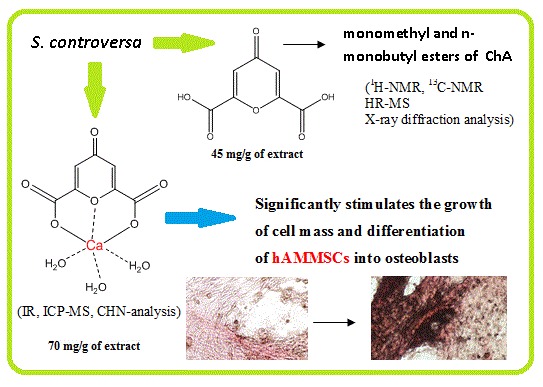The paper of NIOCh's researchers E. Shults and T. Rybalova (co-authors) is published in the journal Biomolecules, (IF 4,964I)
Chelidonic Acid and Its Derivatives from Saussurea Controversa: Isolation, Structural Elucidation and Influence on the Osteogenic Differentiation of Multipotent Mesenchymal Stromal Cells In Vitro
El. Avdeeva, E. Shults, T. Rybalova, Ya. Reshetov, E. Porokhova, I. Sukhodolo, L. Litvinova, V. Shupletsova, O. Khaziakhmatova, I. Khlusov, A. Guryev, M. BelousovBiomolecules, 2019, 9(5), 189
https://doi.org/10.3390/biom9050189

Abstract
4-oxo-4H-pyran-2.6-dicarboxylic acid (chelidonic acid, ChA) in the native state and in the complex with calcium [Ca(ChA)(H2O)3], named saucalchelin (CaChA), was isolated from the extract of Saussurea controversa leaves for the first time for the Asteraceae family. The structure of ChA was determined by NMR, MS and confirmed by X-ray analysis of its monomethyl ester, and CaChA was described by IR, ICP-MS, CHN analysis. The yield of ChA and CaChA was 45 mg/g and 70 mg/g of extract, respectively. The osteogenic activity of ChA, n-monobutyl ester of chelidonic acid, and CaChA has been studied in vitro in a 21-day culture of human adipose-derived multipotent mesenchymal stromal cells (hAMMSCs) in a standard nutrient medium without osteogenic supplements. CaChA significantly stimulated the growth of cell mass and differentiation of hAMMSCs into osteoblasts with subsequent mineralization of the culture and it may be a promising substance for accelerating bone tissue regeneration and engineering. View Full-Text
Keywords: Saussurea controversa DC (Asteraceae); chelidonic acid; 4-oxo-4H-pyran-2.6-dicarboxylic acid esters; X-ray diffraction analysis; human multipotent mesenchymal stromal cells
This is an open access article distributed under the Creative Commons Attribution License which permits unrestricted use, distribution, and reproduction in any medium, provided the original work is properly cited (CC BY 4.0).
Altmetrics:


